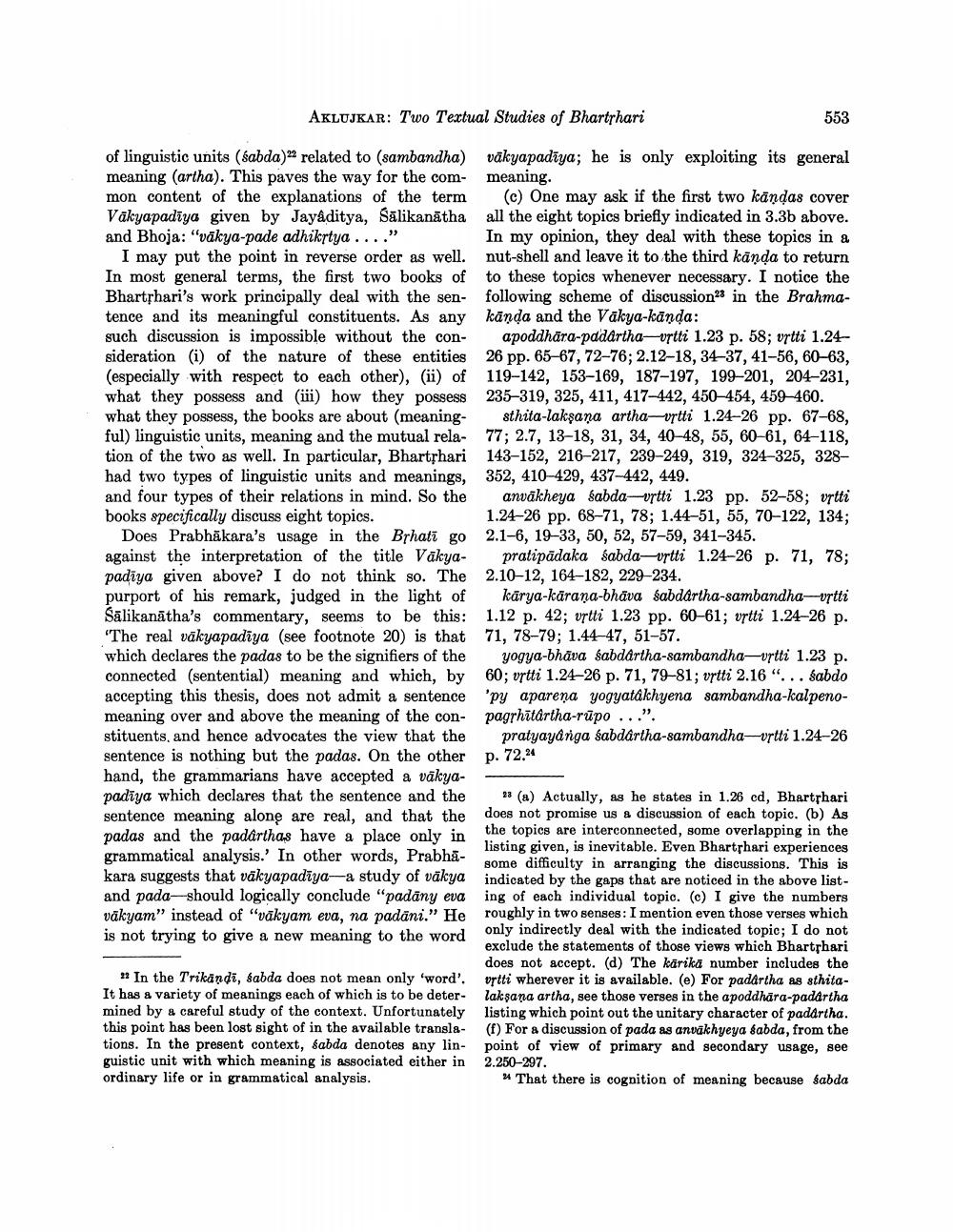Book Title: Two Textual Studies Of Bhartrhari Author(s): Ashok Aklujkar Publisher: Ashok Aklujkar View full book textPage 7
________________ AKLUJKAR: Two Textual Studies of Bharthari 553 of linguistic units (sabda)22 related to (sambandha) vākyapadīya; he is only exploiting its general meaning (artha). This paves the way for the com- meaning. mon content of the explanations of the term (e) One may ask if the first two kāņdas cover Vākyapadīya given by Jayaditya, Sālikanātha all the eight topics briefly indicated in 3.3b above. and Bhoja: "vākya-pade adhikrtya ...." In my opinion, they deal with these topics in a I may put the point in reverse order as well. nut-shell and leave it to the third kända to return In most general terms, the first two books of to these topics whenever necessary. I notice the Bhartphari's work principally deal with the sen- following scheme of discussion in the Brahmatence and its meaningful constituents. As any kānda and the Vākya-kānda: such discussion is impossible without the con- apoddhāra-pddartha-vrtti 1.23 p. 58; vrtti 1.24sideration (i) of the nature of these entities 26 pp. 65-67, 72-76; 2.12-18, 34-37, 41-56, 60-63, (especially with respect to each other), (ü) of 119–142, 153–169, 187–197, 199-201, 204-231, what they possess and (iii) how they possess 235-319, 325, 411, 417-442, 450-454, 459 460. what they possess, the books are about (meaning- sthita-laksana artha-vrtti 1.24-26 pp. 67-68, ful) linguistic units, meaning and the mutual rela- 77; 2.7, 13-18, 31, 34, 40-48, 55, 60-61, 64-118. tion of the two as well. In particular, Bhartshari 143-152, 216–217, 239-249, 319, 324-325, 328– had two types of linguistic units and meanings, 352, 410-429, 437-442, 449. and four types of their relations in mind. So the anvākheya sabda-vrtti 1.23 pp. 52-58; vrtti books specifically discuss eight topics. 1.24-26 pp. 68-71, 78; 1.44-51, 55, 70-122, 134; Does Prabhākara's usage in the Brhati go 2.1-6, 19-33, 50, 52, 57-59, 341-345. against the interpretation of the title Vākya- pratipädaka sabda-vrtti 1.24-26 p. 71, 78: padīya given above? I do not think so. The 2.10-12, 164-182, 229-234. purport of his remark, judged in the light of karya-karana-bhäva sabdartha-sambandha-vrtti Sālikanātha's commentary, seems to be this: 1.12 p. 42; vrtti 1.23 pp. 60-61; vrtti 1.24-26 p. 'The real vākyapadiya (see footnote 20) is that 71, 78-79; 1.44-47, 51-57. which declares the padas to be the signifiers of the yogya-bhāva sabdartha-sambandha-vrtti 1.23 p. connected (sentential) meaning and which, by 60; vrtti 1.24-26 p. 71, 79-81; vrtti 2.16"... Sabdo accepting this thesis, does not admit a sentence 'py aparena yogyatákhyena sambandha-kalpenomeaning over and above the meaning of the con- pagrhītårtha-rūpo...". stituents, and hence advocates the view that the pratyayanga sabdârtha-sambandha-vrtti 1.24-26 sentence is nothing but the padas. On the other p. 72.24 hand, the grammarians have accepted a vākyapadiya which declares that the sentence and the (a) Actually, as he states in 1.26 cd, Bharthari sentence meaning alone are real, and that the does not promise us a discussion of each topic. (b) As padas and the padarthas have a place only in the topics are interconnected, some overlapping in the listing given, is inevitable. Even Bhartshari experiences grammatical analysis.' In other words, Prabha some difficulty in arranging the discussions. This is kara suggests that vākyapadīya-a study of vākya indicated by the gaps that are noticed in the above listand pada-should logically conclude "padany eva ing of each individual topic. (c) I give the numbers väkyam" instead of "vākyam eva, na padāni.” He roughly in two senses: I mention even those verses which is not trying to give a new meaning to the word only indirectly deal with the indicated topic; I do not exclude the statements of those views which Bhartshari does not accept. (d) The kārika number includes the 12 In the Trikändi, sabda does not mean only 'word'. vrtti wherever it is available. (e) For padartha as sthitaIt has a variety of meanings each of which is to be deter- laksana artha, see those verses in the apoddhära-padartha mined by a careful study of the context. Unfortunately listing which point out the unitary character of padartha. this point has been lost sight of in the available transla- () For a discussion of pada as anvakhyeya sabda, from the tions. In the present context, tabda denotes any lin- point of view of primary and secondary usage, see guistic unit with which meaning is associated either in 2.250-297. ordinary life or in grammatical analysis. * That there is cognition of meaning because sabdaPage Navigation
1 ... 5 6 7 8 9 10 11 12 13 14 15 16 17
